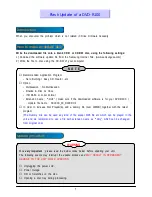
2
CFD-G505
Notes on chip component replacement
•
Never reuse a disconnected chip component.
•
Notice that the minus side of a tantalum capacitor may be
damaged by heat.
Flexible Circuit Board Repairing
•
Keep the temperature of soldering iron around 270˚C during
repairing.
•
Do not touch the soldering iron on the same conductor of the
circuit board (within 3 times).
•
Be careful not to apply force on the conductor when soldering
or unsoldering.
TABLE OF CONTENTS
SAFETY-RELATED COMPONENT WARNING!!
COMPONENTS IDENTIFIED BY MARK
0
OR DOTTED LINE WITH
MARK
0
ON THE SCHEMATIC DIAGRAMS AND IN THE PARTS
LIST ARE CRITICAL TO SAFE OPERATION. REPLACE THESE
COMPONENTS WITH SONY PARTS WHOSE PART NUMBERS
APPEAR AS SHOWN IN THIS MANUAL OR IN SUPPLEMENTS
PUBLISHED BY SONY.
1.
SERVICING NOTES
...............................................
3
2.
GENERAL
...................................................................
4
3.
DISASSEMBLY
3-1.
Disassembly Flow ...........................................................
6
3-2.
Cabinet (Upper) (1) Section ............................................
7
3-3.
Cabinet (Upper) (2) Section ............................................
7
3-4.
Cabinet (Front) Section ...................................................
8
3-5.
TUNER KEY Board, VOL KEY Board ..........................
8
3-6.
LCD Panel Assy ..............................................................
9
3-7.
LED Board ...................................................................... 10
3-8.
LCD Board ...................................................................... 11
3-9.
POWER Board, TRANS Board ....................................... 12
3-10. CD KEY Board ............................................................... 12
3-11. H/P Board, TUNER Board .............................................. 13
3-12. MAIN Board .................................................................... 13
3-13. CD Block Section ............................................................ 14
3-14. Optical Pick-up (KSS-213C) ........................................... 14
3-15. Tape Mechanism Deck .................................................... 15
3-16. TC Board ......................................................................... 15
3-17. Main Belt, Sub Belt ......................................................... 16
4.
MECHANICAL ADJUSTMENTS
......................... 17
5.
ELECTRICAL ADJUSTMENTS
.......................... 17
6.
DIAGRAMS
6-1.
Block Diagram – MAIN Section – ................................. 22
6-2.
Block Diagram – TUNER/CD Section – ....................... 23
6-3.
Printed Wiring Board – CD Section – ............................ 24
6-4.
Schematic Diagram –CD Section – ................................ 25
6-5.
Printed Wiring Board – TUNER Section – .................... 26
6-6.
Schematic Diagram – TUNER Section – ....................... 27
6-7.
Printed Wiring Board – TC Section – ............................. 28
6-8.
Schematic Diagram – TC Section – ............................... 29
6-9.
Printed Wiring Board – MAIN Section – ....................... 30
6-10. Schematic Diagram – MAIN Section (1/2) – ................. 31
6-11. Schematic Diagram – MAIN Section (2/2) – ................. 32
6-12. Printed Wiring Board – LCD Section – .......................... 33
6-13. Printed Wiring Board – POWER Section – .................... 34
6-14. Schematic Diagram – POWER Section – ...................... 35
7.
EXPLODED VIEWS
7-1.
Overall Section ................................................................ 40
7-2.
Cabinet (Front) Section ................................................... 41
7-3.
Cabinet (Rear) Section .................................................... 42
7-4.
Cabinet (Upper) (1) Section ............................................ 43
7-5.
Cabinet (Upper) (2) Section ............................................ 44
7-6.
Tape Mechanism Deck Section ....................................... 45
7-7.
Optical Pick-up Section (KSM-213CDP/C2NP) ............ 46
8.
ELECTRICAL PARTS LIST
.................................. 47
UNLEADED SOLDER
Boards requiring use of unleaded solder are printed with the lead-
free mark (LF) indicating the solder contains no lead.
(Caution: Some printed circuit boards may not come printed with
the lead free mark due to their particular size)
: LEAD FREE MARK
Unleaded solder has the following characteristics.
•
Unleaded solder melts at a temperature about 40
°
C higher
than ordinary solder.
Ordinary soldering irons can be used but the iron tip has to be
applied to the solder joint for a slightly longer time.
Soldering irons using a temperature regulator should be set to
about 350
°
C.
Caution: The printed pattern (copper foil) may peel away if
the heated tip is applied for too long, so be careful!
•
Strong viscosity
Unleaded solder is more viscou-s (sticky, less prone to flow)
than ordinary solder so use caution not to let solder bridges
occur such as on IC pins, etc.
•
Usable with ordinary solder
It is best to use only unleaded solder but unleaded solder may
also be added to ordinary solder.
Dimensions
Approx. 530
×
241
×
369 mm (w/h/d)
(20
7
/
8
×
9
1
/
2
×
14
5
/
8
inches) (incl. projecting parts)
Mass
Approx. 8.0 kg (17 lb. 10 oz) (incl. batteries)
Supplied accessories
AC power cord (1)
Remote control (1)
Design and specifications are subject to change without notice.



































